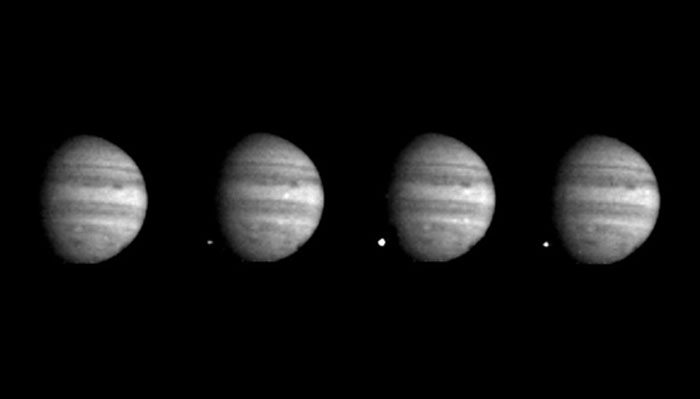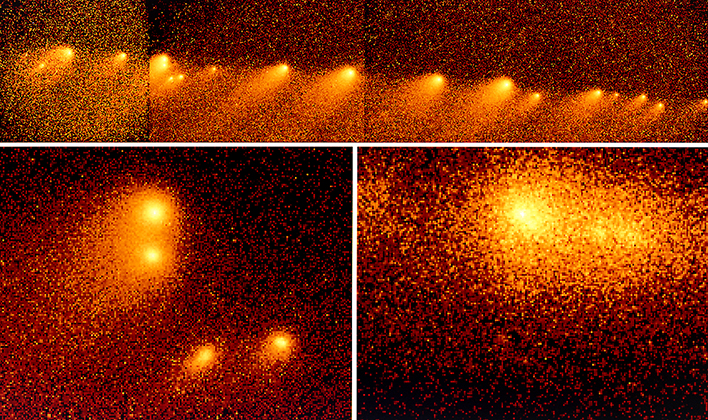.

Comet Shoemaker-Levy 9 Fragment W Impact With Jupiter
These four images of Jupiter and the luminous night-side impact of fragment W of Comet Shoemaker-Levy 9 were taken by the Galileo spacecraft on July 22, 1994. The spacecraft was 238 million kilometers (148 million miles) from Jupiter at the time, and 621 million kilometers from Earth. The spacecraft was about 40 degrees from Earth's line of sight to Jupiter, permitting this direct view. The images were taken at intervals of 2 1/3 seconds, using the green filter (visible light). The first image, taken at an equivalent time to 8:06:10 Greenwich Mean Time (1:06 a m. Pacific Daylight Time), shows no impact. In the next three images, a point of light appears, brightens so much as to saturate its picture element, and then fades again, seven seconds after the first picture. The location is approximately 44 degrees south as predicted, dark spots to the right are from previous impacts. Jupiter is approximately 60 picture elements in diameter. Galileo tape-recorded most of its observations of the Shoemaker-Levy events during the second week of July 1994 and has since been playing the tape back selectively. Many more pictures and data from other instruments remain to be returned from the spacecraft's tape recorder. Playbacks will continue through January 1995. It is not yet certain whether the data relate to meteor bolides (the comet fragment entering Jupiter's atmosphere) or to the subsequent explosion and fireball. Once all the Galileo, Hubble Space Telescope and groundbased data are integrated, an excellent start-to-finish characterization of these remarkable phenomena will be available. The Galileo project, whose primary mission is the exploration of the Jupiter system in 1995 through 1997, is managed by the Jet Propulsion Laboratory for NASA's Office of Space Science.
.
Twenty years ago, human and robotic eyes observed the first recorded impact between cosmic bodies in the solar system, as fragments of comet Shoemaker-Levy 9 slammed into the atmosphere of Jupiter. Between July 16 and July 22, 1994, space- and Earth-based assets managed by NASA's Jet Propulsion Laboratory in Pasadena, California, joined an armada of other NASA and international telescopes, straining to get a glimpse of the historic event:
- NASA's Galileo spacecraft, still a year-and-a-half out from its arrival at Jupiter, had a unique view of fireballs that erupted from Jupiter's southern hemisphere as the comet fragments struck.
- NASA's Hubble Space Telescope, using the JPL-developed and -built Wide Field and Planetary Camera 2, observed the comet and the impact scars it left on Jupiter.
- The giant radio telescopes of NASA's Deep Space Network -- which perform radio and radar astronomy research in addition to their communications functions -- were tasked with observing radio emissions from Jupiter's radiation belt, looking for disturbances caused by comet dust.
- NASA's Voyager 2 spacecraft, then about 3.7 billion miles (6 billion kilometers) from Jupiter, observed the impacts with its ultraviolet spectrometer and a planetary radio astronomy instrument.
- The Ulysses spacecraft also made observations during the comet impact from about 500 million miles (800 million kilometers) away. Ulysses observed radio transmissions from Jupiter with its combined radio wave and plasma wave instrument.
The work of scientists in studying the Shoemaker-Levy 9 impact raised awareness about the potential for asteroid impacts on Earth and the need for predicting them ahead of time, important factors in the formation of NASA's Near-Earth Object Program Office. The NEO Program Office coordinates NASA-sponsored efforts to detect, track and characterize potentially hazardous asteroids and comets that could approach Earth.
The Galileo mission was managed by NASA's Jet Propulsion Laboratory in Pasadena, California, for the agency's Science Mission Directorate. JPL also manages the Voyager mission and the Deep Space Network for NASA. NASA's Near-Earth Object Program at NASA Headquarters, Washington, manages and funds the search, study and monitoring of asteroids and comets whose orbits periodically bring them close to Earth. JPL manages the Near-Earth Object Program Office for NASA's Science Mission Directorate in Washington. JPL is a division of the California Institute of Technology, Pasadena.
.

The freight train of Shoemaker-Levy 9 fragments before they crashed into Jupiter.
.
Comet Shoemaker-Levy 9 was captured by the gravity of Jupiter, torn apart and then crashed into the giant planet in July 1994.
When the comet was discovered in 1993, it already had been torn into more than 20 pieces traveling around the planet in a two year orbit. Further observations revealed the comet (believed to be a single body at the time) had made a close approach to Jupiter in July 1992 and was torn apart by tidal forces resulting from planet's powerful gravity. The comet was thought to have been orbiting Jupiter for about a decade before its demise.
The disruption of a comet into multiple fragments was rare and observing a captured comet in orbit about Jupiter was even more unusual, but the biggest and rarest revelation was that the fragments were going to smash into Jupiter.
NASA had spacecraft in position to watch - for the first time in history - a collision between two bodies in the solar system.
NASA's Galileo orbiter (then still en route to Jupiter) captured unprecedented direct views as the string of fragments labeled A through W smashed into Jupiter's cloud tops. The impacts started on 16 July 1994 and ended on 22 July 1994.
Many Earth-based observatories and orbiting spacecraft including Hubble Space Telescope, Ulysses and Voyager 2 also studied the impact and its aftermath.
The "freight train" of fragments smashed into Jupiter with the force of 300 million atomic bombs. The fragments created huge plumes that were 2,000 to 3,000 kilometers (1,200 to 1,900 miles) high, and heated the atmosphere to temperatures as hot as 30,000 to 40,000 degrees Celsius (53,000 to 71,000 degrees Fahrenheit). Shoemaker-Levy 9 left dark, ringed scars that were eventually erased by Jupiter's winds.
.

Comet Fragment Slams into Jupiter
Date: 17 Jul 1994
In July 1994, 21 chunks of comet Shoemaker-Levy 9, which had broken apart a year earlier, slammed into Jupiter. The Hubble telescope recorded this spectacular event.
These images, beginning at lower right, chronicle the results of one such collision. Hubble began snapping pictures of the impact area just five minutes after the collision. Nothing can be seen. Less than two hours later, a plume of dark debris is visible [bull's-eye pattern, image second from bottom]. Two impact sites are visible in the next picture, taken a few days later. The final snapshot shows three impact sites, the newest near the bull's-eye-shaped region.
.
While the impact was dramatic, it was more than a show. It gave scientists an opportunity to gain new insights into Jupiter, Shoemaker-Levy 9 and cosmic collisions in general. Researchers were able to deduce the composition and structure of the comet. The collision also left dust floating on the top of Jupiter's clouds. By watching the dust spread across the planet, scientists were able to track high-altitude winds on Jupiter for the first time. And by comparing changes in the magnetosphere with changes in the atmosphere following the impact, scientists were able to study the relation-ship between them.
Scientists have calculated that the comet was originally about 1.5 to 2 kilometers (0.9 to 1.2 miles) wide. If a similar-sized object were to hit Earth, it would be devastating. The impact might send dust and debris into the sky, creating a haze that would cool the atmosphere and absorb sunlight, enveloping the entire planet in darkness. If the haze lasted long enough, plant life would die - along with the people and animals that depend on it to survive.
These kinds of collisions were more frequent in the early solar system. In fact, comet impacts were probably the main way that elements other than hydrogen and helium got to Jupiter.
Today, impacts of this size probably occur only every few centuries - and pose a real threat.
Discovery
Shoemaker-Levy 9 was discovered by Carolyn and Gene Shoemaker and David Levy in a photograph taken on 18 March 1993 with the 0.4-meter Schmidt telescope at Mt. Palomar.
How Shoemaker-Levy 9 Got Its Name
The comet was named for its discoverers. Comet Shoemaker-Levy 9 was the ninth short-periodic comet discovered by Eugene and Carolyn Shoemaker and David Levy.
Quelle: NASA
4948 Views
